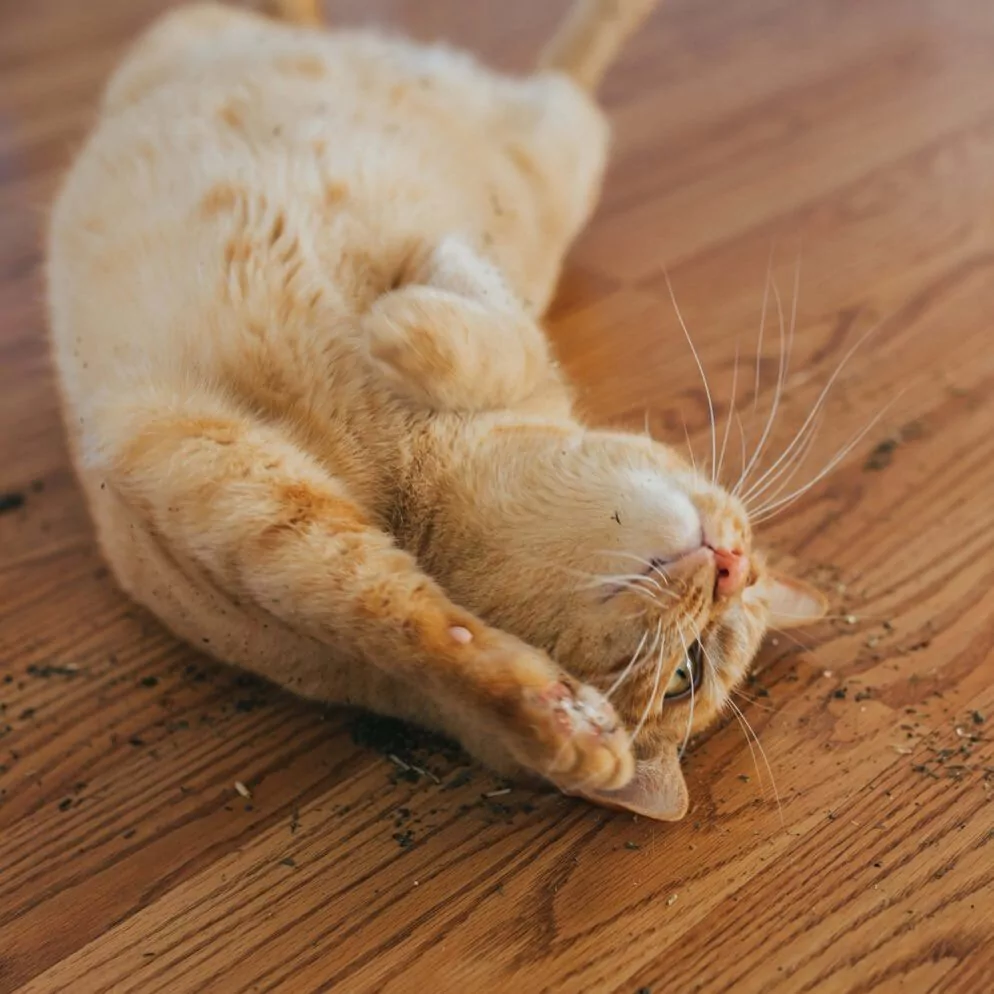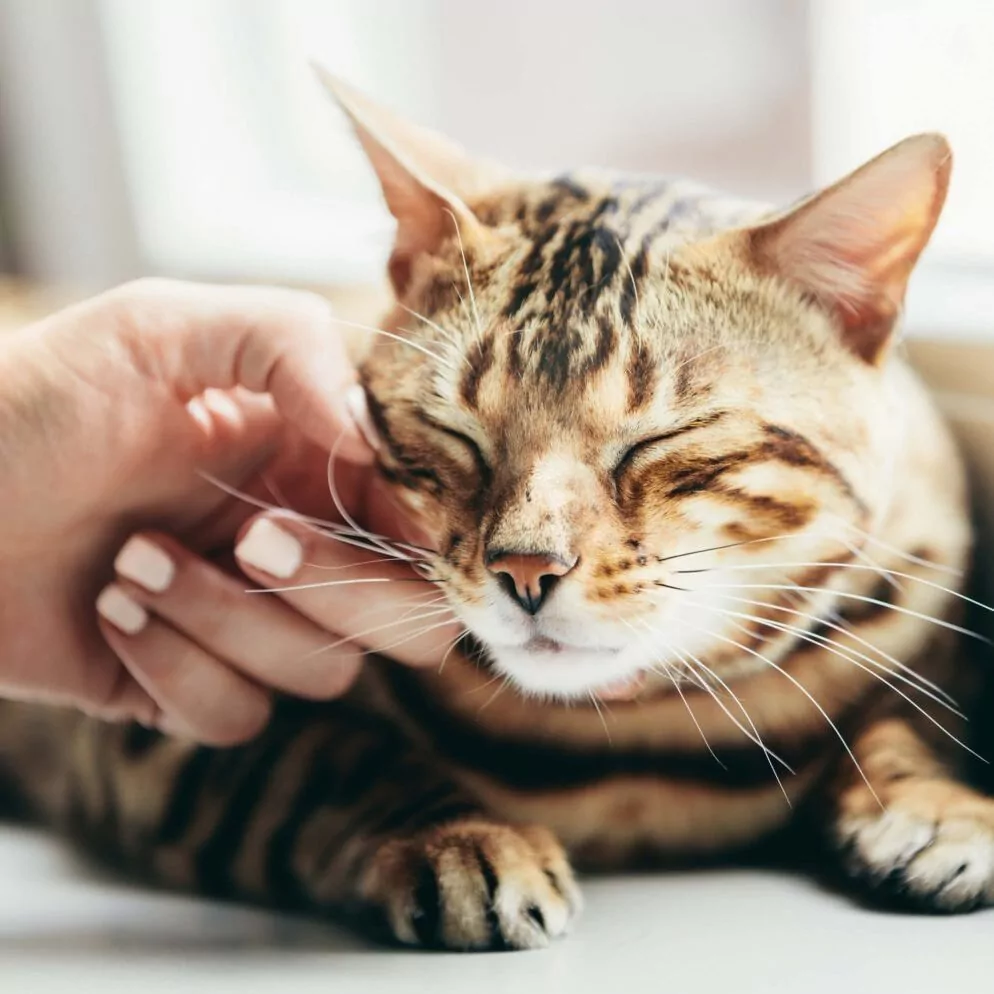Cat Health
Cats 2.0: Understanding Your Cat’s Unique Reproductive System

Many cat parents are unaware that just like human teenagers, their cute young kitten can be sexually active before being considered an adult. Next thing you know, you’re dealing with an unwanted teen kitty pregnancy! Here’s what you need to know about the feline reproductive system, and why spaying and neutering is inextricably linked to a cat’s everyday good health and welfare.
Cats can be prolific breeders, capable of birthing dozens of kittens in a lifetime. This is something even the ancient Egyptians recognized, as Bastet, the goddess of fertility, is depicted as a cat in both statues and artworks of that time.
“Because female cats are sexually active at five months of age – when they are mere kittens themselves — cat parents are often caught off guard,” says Philip A. Bushby, DVM, MS, DACVS, Professor Emeritus Mississippi State University College of Veterinary Medicine.
This explains why a young male cat is suddenly trying to get out of the house looking to party with the neighborhood females and not coming home until the wee hours of the morning. And why a female teenage kitten in heat is loud and noisy, rolling around the house in an unruly, overtly affectionate sexual manner.
Further, cats, throughout their lives, are capable of multiple pregnancies within a single reproductive season. You can joke that your tom cat is the neighborhood stud and your female cat’s body movements are embarrassingly like “kitty porn” on your living room carpet. But this is really no laughing matter, as being a prolific breeder can take an enormous toll on a cat’s health.
If you are not an ethical cat breeder producing the next generation of health-tested pedigree kittens, part of being a responsible cat parent means knowing when to spay or neuter, procedures that prevent unwanted litters and offer enormous health benefits throughout a cat’s life. Let’s start with these basic feline facts.
Feline Reproductive System Basics
The major organs of the female reproductive tract:
- The ovaries.
- The fallopian tubes.
- The uterus.
- The vagina, which provides a passage way from the uterus to outside of the body.
- The mammary glands, which run in two rows along the outside of the abdomen, from the groin to the chest. Cats typically have four or five pairs of mammary glands, allowing the female to both store and produce milk to feed her kittens.
- The cervix, a muscular tube that separates the uterus from the vagina and relaxes during fertilization and birth.
The ovaries, fallopian tubes, and uterus are located inside the abdomen. As with humans, the ovaries produce eggs and essential hormones such as estrogen and progesterone. They are connected to the uterus by the fallopian tube. The uterus is where fertilized eggs develop into fetuses and where they remain until they are ready to be delivered via the vagina.
The major male reproductive organs:
- The testes, (also called testicles), which produce sperm. Sperm production is influenced by testosterone, a hormone produced by the testicles.
- The scrotum. This is where the testicles are situated.
- The penis. Rough little spines called papillae protrude from the penis’s surface in intact male cats. These rough projections are responsible for stimulating the female cat to ovulate during mating. Neutering the cat causes the spines to disappear.
Unique Traits of the Feline Reproductive System
Cats are considered polyestrous, which means they naturally experience multiple heat cycles during the reproductive season. There actually is a reproductive season and, consequently, a ‘kitten season’ aligned with the seasonal calendar. In the northern hemisphere, the queen (female cat) comes into heat every two weeks starting in late January. This continues through the end of September. During the last three months of the year – October through December — cats tend to stop cycling until the new season resumes in late January.
Factors That Influence the Reproductive Season
Cats with an indoor lifestyle who live with artificial lighting may come in heat any time of the year. Apart from artificial lighting, other factors that contribute to bringing on a cat’s mating season are longer hours of daylight, warm temperatures, and the presence of other cats. The hours of sunlight are called a photoperiod.
Longhaired cats are more sensitive to light and temperature than shorthaired breeds, according to 1985 and 1995 studies cited in Canine and Feline Endocrinology and Reproduction. Interestingly, breeds such as Persians, Abyssinians, and Burmese generally go into heat when they are older than other breeds.
Throughout the breeding season, queens go into and out of heat several times but not always at regular intervals. Most queens go into heat every three weeks if not mated; some once a month; others just once or twice during the season. Each queen establishes her own normal rhythm. Knowing about the stages of the heat cycle will help you understand your cat’s behavior.
The term ‘in heat’ refers to when a cat is ready to mate and is fertile. This natural cycle begins around the very young age of five months. Female cats do have a monthly cycle, but instead of shedding the uterine lining like women, cats reabsorb the old uterine lining rather than bleeding it out.
Signs a Cat Is In Heat
A cat in heat vocalizes excessively (think feline opera star) in an attempt to attract any males in the neighborhood. She also emits a “come hither” scent that males from all around will respond to. She will become even more affectionate than usual, rubbing her head and neck against people, rolling and squirming on the carpet and assuming the mating posture (the rump in the air, tail deflected to the side, and back arched downward), along with making “treading” movements with her back legs.
Outlining the Feline Mating Season
Proestrus Period (courtship): This period lasts a couple of days and occurs just before she goes in heat. She is not quite ready to mate and shows no overt signs but may attract unneutered males.
Estrus Period (mating): This “in heat” period lasts three to five days if a cat mates and up to 14 days if she doesn’t. This is really the time to watch her because she will try to get out of the house in search of male cats.
If there are tomcats in the area (or even in the household), fights may break out as they vie for her attention. The victorious male will then pursue the female, who appears to play “hard to get.” Premature attempts to mate by the male often elicit a very aggressive rebuff by the female. After a while, however, the female becomes ready to mate and will assume the mating posture.
The male will grasp the female by the skin over the nape of her neck and begin copulation. When the male ejaculates, the female produces a loud shriek, hisses aggressively, and violently swats the male away. The female’s reaction is believed to be due to pain upon withdrawal by the male, caused by the barbs on the penis. After mating, the female rolls around on the ground while the male retires a discreet distance away. This mating process is often repeated several times. A female may mate with more than one male during the heat cycle and her kittens can have different fathers.
Interestrus: The period between estrus cycles if the female isn’t bred. Length: 2 to 3 weeks.
Metestrus (or Diestrus): Theperiod after estrus or mating. What happens next depends on what happened during estrus. If the cat is pregnant, her pregnancy will last 58 to 70 days. If she was not mated, she enters a 7- to 28-day period of sexual quietness, after which she begins the courtship stage again.
Anestrus: The period of inactivity (sexual and hormonal) between estrus phases. It usually lasts two to three months. * Because the cycle is over and the cat is not in heat, this is the ideal time to schedule the ovariohysterectomy (spay) surgery in an adult cat.
It’s important to know that lactation, production of milk, does not suppress the heat cycle. Cats who are actively nursing kittens can come into heat as soon as two weeks after giving birth. Even being pregnant doesn’t necessarily suppress the heat cycle. In fact, 10 percent of female cats come into heat between the third and sixth week of pregnancy. Although these cycles are rarely fertile, it is theoretically possible for a cat to be carrying fetuses of different ages, resulting from separate matings in different heat cycles! (The scientific term for this is superfetation.)
All these unique feline reproductive features, along with pregnancies that on average are between 65 to 67 days (the gestation period), means that the reproductive cycle is very hectic for a female cat!
If she is not spayed, this will continue her entire life, taking a huge toll on her general health and wellbeing. https://www.ncbi.nlm.nih.gov/pmc/articles/PMC7158189/
Your Cat Is Pregnant. Now What?
The first thing NOT to do is go on Facebook seeking the advice of random “friends”!
“If the pregnancy for the cat is not planned and, if a cat owner suddenly discovered the cat was pregnant, this most likely is the case, I would advise spaying the cat immediately,” says Bushby. “Why bring more kittens into the world when shelters are euthanizing kittens because there and not enough homes for them?
“The bottom line is as long as more kittens are born each year than there are homes for them, then kittens will be euthanized in shelters or will be released into the wild to become feral cats,” he says.
Safely Spaying a Pregnant Cat
“Spaying a pregnant cat is safe and not much more difficult than spaying one that is not pregnant. Even if the cat is near term, the fetus/fetuses are asleep because of the anesthesia for the spay and they just never wake up. Obviously, none of these three options are ideal, but spaying the pregnant cat is by far the most humane,” he adds.
“If a cat is nursing a litter of kittens my personal recommendation is to perform a flank spay (not the standard ventral midline abdominal spay),” says Bushby. “With a flank spay, the incision is not located near the mammary glands, so there is much less of a chance of the kittens’ nursing activities disrupting the wound closure. Further, spaying while the kittens are nursing does not impact the production of milk for the kittens,” he adds.
Vital Nutrition and Care for the Mother Cat and Her Babies
If the cat is allowed to give birth to kittens, Bushby says it is vital to increase her food intake both before and after birth.
If the intention is to spay after the litter has been born, he further warns that the mother cat should be protected from any intact male cats in the household and be prevented from getting out as she can easily become pregnant again before the kittens are even weaned!
The Feline Fix by Fix Initiative
Because it’s impossible to predict exactly when that first heat cycle will occur, many veterinary feline organizations are now promoting the Feline Fix by Five initiative introduced some years ago by animal advocate organization Marian’s Dream. It promotes spaying and neutering cats before five months of age – before any sexual activity can take place. www.felinefixbyfive.org. The procedure is called an elective gonadectomy. Ovariohysterectomy is the term for spaying a female; orchiectomy or castration is the terminology that applies to males.
Spay/neuter of cats prior to five months of age has the support of many leading organizations, including the American Veterinary Medical Association (AVMA), American Association of Feline Practitioners, Association of Shelter Veterinarians, American Animal Hospital Association, EveryCat Health Foundation (formerly Winn Feline Foundation), Catalyst Council, Cat Fancier’s Association, and The International Cat Association.
Life-Threatening Medical Issues Affecting the Female Reproductive System
Female cats allowed to breed indiscriminately are prone to two life-threatening conditions related to their reproductive system.
“Mammary neoplasia (cancerous tumors in the mammary glands), are the third most common tumors in cats,” Bushby says. “Mammary tumors are 90 percent malignant and the cat’s survival is less than a year. Mammary neoplasia is considered a fatal disease.
“If cats are spayed prior to the first heat cycle, in other words, before they are five months of age, the incidence of mammary neoplasia is almost zero. If the cat has had one heat cycle, the incidence increases and, if they are spayed after the second heat cycle or left intact, the incidence increases vastly. Thus, spaying appropriately before they reach sexual maturity can be considered life-saving,” he says.
The other medical issue that threatens the reproductive system is pyometra, an infection in the uterus.
“It’s also considered a serious and life-threatening condition that must be treated quickly and aggressively,” Bushby says. “Further, spaying a cat at any age eliminates the incidence of ovarian tumors too.”
Positive Behavioral Changes in Male Cats
No medical issues are similarly life-threatening to male cats, so the life-saving impact of neutering males is not as dramatic. However, veterinarians who support the Feline Fix by Five movement say that early neutering is equally important because it greatly impacts unwanted behaviors.
“For years veterinarians were taught not to neuter until sexually mature because this could predispose them to urinary obstructions,” says Bushby. “But this has since been disproven. And if you castrate before a male cat is sexually mature, you are preventing unnecessary roaming and fighting with other male cats looking for mates,” he explains.
“In 2013, the Banfield Pet Hospital group did a study on the life expectancy of cats and they discovered that the life expectancy for intact male cats was only six years. While the life-expectancy for neutered male cats was 10 to 11 years. Why the difference? Well, castrated males are not out roaming where they are subject to being hit by cars, attacked by predators and suffering all kinds of traumas that predisposes them to injuries and even death. So, their life expectancy is inextricably linked to their sexual behavior,” he says.
Summarizing the Feline Reproductive System
Allowing a cat to continually breed takes a toll on her health and even threatens her life. It’s sad to allow kittens to be born and, because there are not enough homes, simply euthanize them. With a better understanding of the feline reproductive system, every cat lover can help by being a more responsible and humane cat parent. Spaying and neutering cats before they are five months old saves lives and promotes good health. That’s a win-win.
Feline Reproductive Facts
- There are no valid reasons for letting a cat have an estrous cycle or have a litter of kittens before being spayed.
- It’s a myth that female cats are more friendly and sociable if they are allowed to have a litter of kittens.
- When it comes to breeding, cats don’t discriminate between brothers, fathers, and sons, so don’t assume they won’t mate with each other!
Did you find this helpful? Share it!
About VetScoop
Pets make our lives better. At VetScoop, we’re on a mission to return the favor by giving you access to trustworthy, science-based information so you can provide the best possible care for your pets.
Related Articles We Think You'd Like





